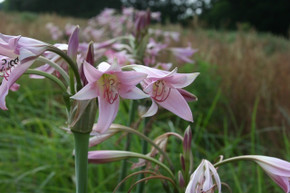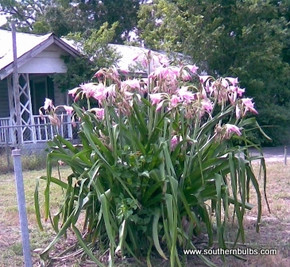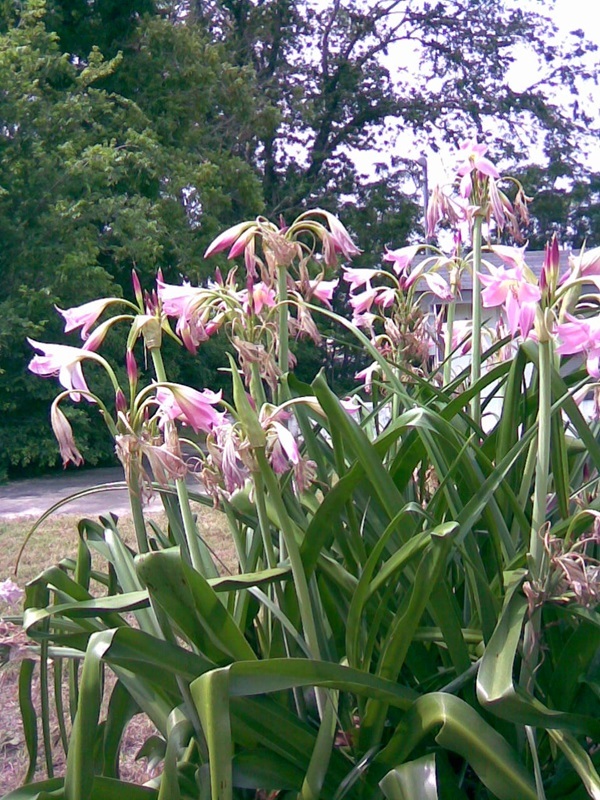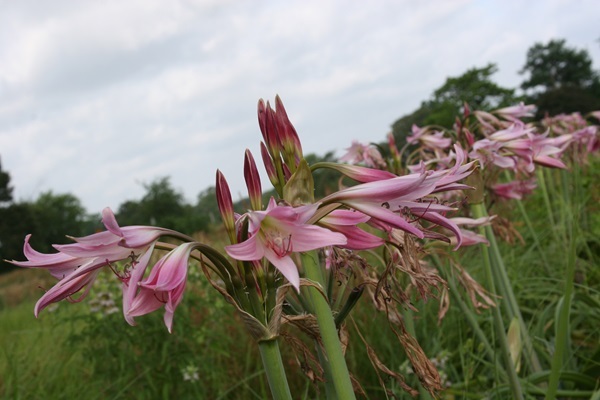

Not all bulbs are dug. Our first pink crinums were a gift from a friend. Years ago, we planted rows of this flower in an abandoned sweet potato field that is now our farm. Then we walked away. Four years later, the bulbs had turned into large clumps of five or more bulbs and sent up two to three bloom stalks every year. They compete with the weeds, hogs, and grasshoppers, using nothing but the natural rainfall to survive.

Crinum powellii comes in two different colors, pink and white. It is one of the most cold hardy of all the crinums, but that in no way means that it cannot stand the heat. Some of the toughest, oldest crinums we have are Crinum powelii. I was in South Carolina at a plantation where I saw one blooming in the middle of a VERY hot and humid day. On top of this, you don't need to worry about it dying (unless you spray some kind of chemical on it or live in a cold environment - Zones 7 and colder), because it is one of the toughest bulbs in the garden! My former professor, Dr. Bill Welch once said, "No crinum in the South has ever died."

Planting: Cover the bulb itself but leave the neck exposed. If you are in zone 7, we would suggest taking some precautions and mulching well over your crinums and maybe even covering them if it is a hard winter.

Blooms: The robust foliage of this crinum curves a little more than others, and it is a nice glossy green color that is attractive even when the plant is not in bloom. The light pink blooms are 2" lily-shaped trumpets. Established bulbs send up 4-5 foot tall stalks with multiple flowers on each stalk.
Winter: If you are in zone 7, we would suggest taking some precautions and mulching well over your crinums if you want them to come back. During the winter, as most crinums do in colder areas, the foliage will die down completely. The bulb is healthy and just waiting for the next warm season to spring back to life. This opens up an opportunity to plant other winter growing bulbs to hide the foliage and barren stalks of the crinum. Lycoris radiata, Narcissus tazetta Grand Primo, and other strong winter bulb foliage plants are good choices and allow you to pack in more color into more spaces.

Large bulbs are 1) quicker in their life to dividing and producing more offsets (babies) and 2) have a higher likelihood of larger and more blooms the first year.
Plant now in good garden soil with plenty of sun. Water regularly during the hot dry months of summer. They will bulk up and multiply quickly!
Crinums don't like to be moved so they won't bloom for you this year, but give them time to get adjusted and enjoy the display of blooms next year! It may take the small bulbs a couple of years to bloom, but they will eventually give you some beautiful blooms.
Not all bulbs are dug. Our first pink crinums were a gift from a friend. Years ago, we planted rows of this flower in an abandoned sweet potato field that is now our farm. Then we walked away. Four years later, the bulbs had turned into large clumps of five or more bulbs and sent up two to three bloom stalks every year. They compete with the weeds, hogs, and grasshoppers, using nothing but the natural rainfall to survive.

Crinum powellii comes in two different colors, pink and white. It is one of the most cold hardy of all the crinums, but that in no way means that it cannot stand the heat. Some of the toughest, oldest crinums we have are Crinum powelii. I was in South Carolina at a plantation where I saw one blooming in the middle of a VERY hot and humid day. On top of this, you don't need to worry about it dying (unless you spray some kind of chemical on it or live in a cold environment - Zones 7 and colder), because it is one of the toughest bulbs in the garden! My former professor, Dr. Bill Welch once said, "No crinum in the South has ever died."

Planting: Cover the bulb itself but leave the neck exposed. If you are in zone 7, we would suggest taking some precautions and mulching well over your crinums and maybe even covering them if it is a hard winter.

Blooms: The robust foliage of this crinum curves a little more than others, and it is a nice glossy green color that is attractive even when the plant is not in bloom. The light pink blooms are 2" lily-shaped trumpets. Established bulbs send up 4-5 foot tall stalks with multiple flowers on each stalk.
Winter: If you are in zone 7, we would suggest taking some precautions and mulching well over your crinums if you want them to come back. During the winter, as most crinums do in colder areas, the foliage will die down completely. The bulb is healthy and just waiting for the next warm season to spring back to life. This opens up an opportunity to plant other winter growing bulbs to hide the foliage and barren stalks of the crinum. Lycoris radiata, Narcissus tazetta Grand Primo, and other strong winter bulb foliage plants are good choices and allow you to pack in more color into more spaces.

Large bulbs are 1) quicker in their life to dividing and producing more offsets (babies) and 2) have a higher likelihood of larger and more blooms the first year.
Plant now in good garden soil with plenty of sun. Water regularly during the hot dry months of summer. They will bulk up and multiply quickly!
Crinums don't like to be moved so they won't bloom for you this year, but give them time to get adjusted and enjoy the display of blooms next year! It may take the small bulbs a couple of years to bloom, but they will eventually give you some beautiful blooms.